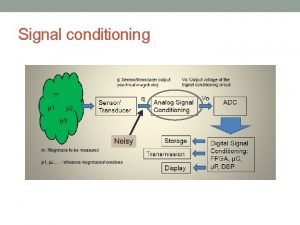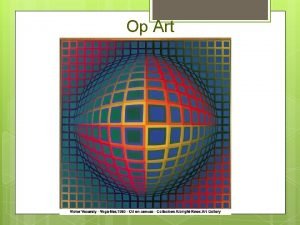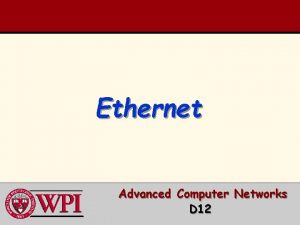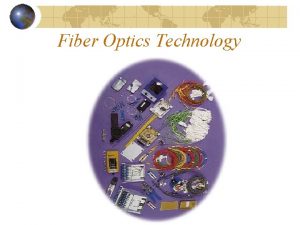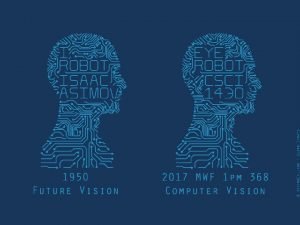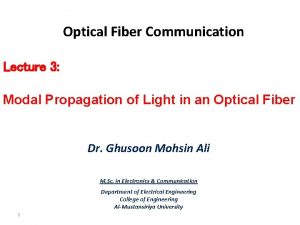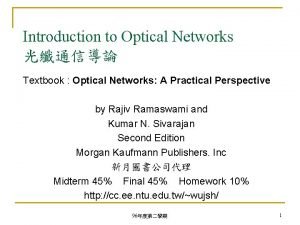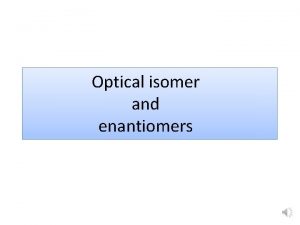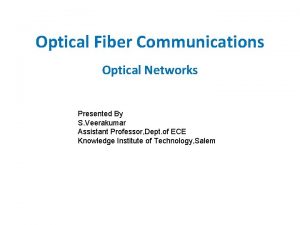Historical overview of optical networks Historical overview of


































- Slides: 34

Historical overview of optical networks

Historical overview of optical networks • Optical fiber provides several advantages – Unprecedented bandwidth potential far in excess of any other known transmission medium – A single strand of fiber offers a total bandwidth of 25 000 GHz <=> total radio bandwidth on Earth <25 GHz – Apart from enormous bandwidth, optical fiber provides additional advantages (e. g. , low attenuation) • Optical networks aim at exploiting unique properties of fiber in an efficient & costeffective manner

Historical overview of optical networks • Optical networks – (a) Point-to-point link • Initially, optical fiber used for point-to-point transmission systems between pair of transmitting and receiving nodes • Transmitting node: converts electrical data into optical signal (EO conversion) & sends it on optical fiber • Receiving node: converts optical signal back into electrical domain (OE conversion) for electronic processing & storage

Historical overview of optical networks • Optical networks – (b) Star network • Multiple point-to-point links are combined by a star coupler to build optical single-hop star networks • Star coupler is an optical broadcast device that forwards an optical signal arriving at any input port to all output ports • Similar to point-to-point links, transmitters perform EO conversion and receivers perform OE conversion

Historical overview of optical networks • Optical networks – (c) Ring network • Interconnecting each pair of adjacent nodes with point-topoint fiber links leads to optical ring networks • Each ring node performs OE and EO conversion for incoming & outgoing signals, respectively • Combined OE & EO conversion is called OEO conversion • Real-world example: fiber distributed data interface (FDDI)

Historical overview of optical networks • SONET/SDH – Synchronous optical network (SONET) & its closely related synchronous digital hierarchy (SDH) standard is one of the most important standards for optical point-topoint links – Brief SONET history • Standardization began during 1985 • First standard completed in June 1988 • Standardization goals were to specify optical point-to-point transmission signal interfaces that allow – interconnection of fiber optics transmission systems of different carriers & manufacturers – easy access to tributary signals – direct optical interfaces on terminals – to provide new network features

Historical overview of optical networks • SONET/SDH – SONET defines • standard optical signals • synchronous frame structure for time division multiplexed (TDM) digital traffic • network operation procedures – SONET based on digital TDM signal hierarchy with periodically recurring time frame of 125 µs – SONET frame structure carries payload traffic of various rates & several overhead bytes to perform network operations (e. g. , error monitoring, network maintenance, and channel provisioning)

Historical overview of optical networks • SONET/SDH – Globally deployed by large number of major network operators – Typically, SONET point-to-point links used to build optical ring networks with OEO conversion at each node – SONET rings deploy two types of OEO nodes • Add-drop multiplexer (ADM) – Usually connects to several SONET end devices – Aggregates or splits SONET traffic at various speeds • Digital cross-connect system (DCS) – Adds and drops individual SONET channels at any location – Able to interconnect a larger number of links than ADM – Often used to interconnect SONET rings

Historical overview of optical networks • Multiplexing – Rationale • Huge bandwidth of optical fiber unlikely to be used by single client or application => bandwidth sharing among multiple traffic sources by means of multiplexing – Three major multiplexing approaches in optical networks • Time division multiplexing (TDM) • Space division multiplexing (SDM) • Wavelength division multiplexing (WDM)

Historical overview of optical networks • Multiplexing – Time division multiplexing (TDM) • SONET/SDH is an important example of optical TDM networks • TDM is well understood technique used in many electronic network architectures throughout 50 -year history of digital communications • In high-speed optical networks, however, TDM is limited by the fastest electronic transmitting, receiving, and processing technology available in OEO nodes, leading to socalled electro-optical bottleneck • Due to electro-optical bottleneck, optical TDM networks face severe problems to fully exploit enormous bandwidth of optical fibers

Historical overview of optical networks • Multiplexing – Space division multiplexing (SDM) • SDM is straightforward solution to electro-optical bottleneck • In SDM, single fiber is replaced with multiple fibers used in parallel, each operating at any arbitrary line rate (e. g. , electronic peak rate of OEO transceiver) • SDM well suited for short-distance transmissions • SDM becomes less practical and more costly for increasing distances since multiple fibers need to be installed and operated

Historical overview of optical networks • Multiplexing – Wavelength division multiplexing (WDM) • WDM can be thought of as optical FDM where traffic from each client is sent on different wavelength • Multiplexer combines wavelengths onto common outgoing fiber link • Demultiplexer separates wavelengths and forwards each wavelength to separate receiver

Historical overview of optical networks • Multiplexing – WDM appears to be the most promising approach to tap into vast amount of fiber bandwidth while avoiding shortcomings of TDM and SDM • Each WDM wavelength may operate at arbitrary line rate well below aggregate TDM line rate • WDM takes full advantage of bandwidth potential without requiring multiple SDM fibers => cost savings – Optical WDM networks widely deployed & studied by network operators, manufacturers, and research groups worldwide – Existing & emerging high-performance optical networks are likely to deploy all three multiplexing techniques, capitalizing on the respective strengths of TDM, SDM, and WDM

Historical overview of optical networks • Optical TDM networks – Progress on very short optical pulse technology enables optical TDM (OTDM) networks at 100 Gb/s and above – High-speed OTDM networks have to pay particular attention to transmission properties of optical fiber – In particular, dispersion significantly limits achievable bandwidth-distance product of OTDM networks due to intersymbol interference (ISI) • With ISI, optical power of adjacent bits interfere, leading to changed optical power levels & transmission errors • ISI is exacerbated for increasing data rates and fiber lengths => decreased bandwidth-distance product – OTDM networks well suited for short-range applications – Long-distance OTDM networks can be realized by using soliton propagation, where dispersion effects are cancelled out by nonlinear effects of optical fiber

Historical overview of optical networks • Optical TDM networks – Optical TDM networks have two major disadvantages • Synchronization is required, which becomes more challenging for increasing data rates of >100 Gb/s • Lack of transparency since OTDM network clients have to match their traffic and protocols to underlying TDM frame structure – Using optical switching components with electronic control paves way to transparent OTDM networks – However, transparent OTDM networks are still in their infancy – Optical WDM networks are widely viewed as more mature solution to realize transparent optical networks • WDM networks do not require synchronization • Each wavelength may be operated separately, providing transparency against data rate, modulation & protocol

Historical overview of optical networks • Optical WDM networks – Optical WDM networks are networks that deploy WDM fiber links with or without OEO conversion at intermediate nodes – Optical WDM networks can be categorized into • (a) Opaque WDM networks => OEO conversion • (b) Transparent WDM networks => optical bypassing • (a)+(b) Translucent WDM networks

Historical overview of optical networks • All-optical networks (AONs) – AONs provide purely optical end-to-end paths between source and destination nodes by means of optically bypassing intermediate nodes => optical transparency – AONs are widely applicable and can be found at all network hierarchy levels – Typically, AONs are optical circuit-switched (OCS) networks • Optical circuits usually switched at wavelength granularity => wavelength-routing networks – AONs deploy all-optical (OOO) node structures which allow optical signals to stay partly in the optical domain – Unlike OEO nodes, OOO nodes do not perform OEO conversion of all wavelength channels => in-transit traffic makes us of optical bypassing

Historical overview of optical networks • AONs vs. SONET/SDH networks – Several similarities and analogies between AONs and SONET/SDH networks • Both networks are circuit-switched systems • TDM slot multiplexing, processing, and switching in SONET/SDH networks <=> WDM wavelength channel multiplexing, processing, and switching in AONs • Add-drop multiplexer (ADM) & digital cross-connect system (DCS) in SONET/SDH networks <=> All-optical replica of ADM & DCS in AONs – Optical add-drop multiplexer (OADM)/wavelength adddrop multiplexer (WADM) – Optical cross-connect (OXC)/wavelength-selective cross-connect (WSXC)

Historical overview of optical networks • OADM – Incoming WDM comb signal optically amplified (e. g. , EDFA) & demultiplexed (DEMUX) into separate wavelengths – Wavelengths bypass remain in optical domain – Traffic on wavelengths drop locally dropped – Local traffic inserted on freed wavelengths add – Wavelengths multiplexed (MUX) & amplified on outgoing fiber

Historical overview of optical networks • OXC – N x M component with N input fibers, N output fibers, and M wavelength channels on each fiber – Each input fiber deploys DEMUX & optical amplifier (optional) – Each wavelength layer uses separate space division switch – Each output fiber deploys DEMUX to collect light from all wavelength layers (plus optional optical amplifier)

Historical overview of optical networks • Optical transport network (OTN) – An AON deploying OADMs and OXCs is referred to as optical transport network (OTN) – Benefits of OTN • Substantial cost savings due to optical bypass capability of OADMs & OXCs • Improved network flexibility and survivability by using reconfigurable OADMs (ROADMs) and reconfigurable OXCs (ROXCs)

Historical overview of optical networks • AONs: Design Goals & Constraints – Two major design goals of AONs • Scalability • Modularity – Transparency enables cost-effective support of large number of applications, e. g. , • • Voice, video, and data Uncompressed HDTV Medical imaging Interconnection of supercomputers – Physical transmission impairments pose limitations on number of network nodes, used wavelengths, and distances => Large AONs must be partitioned into several subnetworks called islands of transparency

Historical overview of optical networks • AONs: Design Goals & Constraints – AONs offer two types of optical paths • Lightpath: optical point-to-point path • Light-tree: optical point-to-multipoint path – Lightpath and light-tree may • be optically amplified • keep assigned wavelength unchanged => wavelength continuity constraint • have assigned wavelength altered along path => wavelength conversion – OXCs equipped with wavelength converters are called wavelength-interchanging cross-connects (WIXCs) – WIXCs improve flexibility of AONs and help decrease blocking probability in AONs since wavelength continuity constraint can be omitted

Historical overview of optical networks • Wavelength conversion Type Definition Fixed conversion Static mapping between input wavelength i and output wavelength j Limited-range conversion Input wavelength i can be mapped to a subset of available output wavelengths Full-range conversion Input wavelength i can be mapped to all available output wavelengths Sparse conversion Wavelength conversion is supported only by a subset of network nodes

Historical overview of optical networks • Wavelength conversion – Wavelength converters may be realized • by OE converting optical signal arriving on wavelength i and retransmitting it on wavelength j (implying OEO conversion) • by exploiting fiber nonlinearities (avoiding OEO conversion) – Benefits of wavelength converters • Help resolve wavelength conflicts on output links => reduced blocking probability • Increase spatial wavelength reuse => improved bandwidth efficiency – At the downside, wavelength converters are rather expensive => solutions to cut costs • Sparse wavelength conversion • Converter sharing inside WIXC – Converter share-per-node approach – Converter share-per-link approach

Historical overview of optical networks • Reconfigurability – Beneficial property of dynamically rerouting and load balancing of traffic in response to traffic load changes and/or network failures in order improve network flexibility & performance – Reconfigurable AONs may be realized by using • • • Tunable wavelength converters (TWCs) Tunable transmitters & receivers Multiwavelength transmitters & receivers Reconfigurable OXCs (ROXCs) Reconfigurable OADMs (ROADMs)

Historical overview of optical networks • ROADM – Conventional OADM becomes reconfigurable by using optical 2 x 2 cross-bar switches on in-transit paths between DEMUX and MUX – Cross-bar switches are electronically controlled independently from each other to locally drop/add (cross state) or forward (bar state) traffic on separate wavelengths

Historical overview of optical networks • Control & Management – Reconfigurable AONs allow to realize powerful telecommunications network infrastructures, but also give rise to some problems • Find optimal configuration for given traffic scenario • Provide best reconfiguration policies in presence of traffic load changes, network failures, and network upgrades • Guarantee proper and efficient operation – To solve these problems, control & management of reconfigurable AONs is key to make them commercially viable

Historical overview of optical networks • Control – Adding control functions to AONs allows to • set up • modify and • tear down optical circuits such as lightpaths and light-trees by (re)configuring tunable transceivers, tunable wavelength converters, ROXCs, and ROADMs along the path – AONs typically use a separate wavelength channel called optical supervisory channel (OSC) to distribute control & management information among all network nodes

Historical overview of optical networks • OSC – Unlike optically bypassing data wavelength channels, OSC is OEO converted at each network node (e. g. , electronic controller of ROADM) – OSC enables both distributed and centralized control of tunable/reconfigurable network elements • Distributed control – Any node is able to send control information to network elements and thus remotely control their state • Centralized control – A single entity is authorized to control the state of network elements – Central control entity traditionally part of network management system (NMS)

Historical overview of optical networks • NMS – NMS acquires and maintains global view of current network status by • issuing requests to network elements and • processing responses and update notifications sent by network elements – Each network element determines and continuously updates link connectivity & link characteristics to its adjacent nodes, stores this information in its adjacency table, and sends its content to NMS – NMS uses this information of all nodes in order to • construct & update view of current topology, node configuration, and link status of entire network • set up, modify, and tear down optical end-to-end connections – Telecommunications Management Network (TMN) framework plays major role in reconfigurable AONs

Historical overview of optical networks • TMN – Jointly standardized by ITU-T and ISO – Incorporates wide range of standards that cover management issues of the so-called FCAPS model • Fault management • Configuration management • Accounting management • Performance management • Security management

Historical overview of optical networks • FCAPS model – Fault management • • Monitoring & detecting fault conditions Correlating internal & external failure symptoms Reporting alarms to NMS Configuring restoration mechanisms – Configuration management • Provides connection set-up and tear-down capabilities • Paradigms for connection set-up and release – Management provisioning (initiated by network administrator via NMS interface) – End-user signaling (initiated by end user via signaling interface without intervention by NMS)

Historical overview of optical networks • FCAPS model – Accounting management • Also known as billing management • Provides mechanisms to record resource usage & charge accounts for it – Performance management • Monitoring & maintaining quality of established optical circuits – Security management • Comprises set of functions that protect network from unauthorized access (e. g. , cryptography)
 Passive optical networks
Passive optical networks Backbone networks in computer networks
Backbone networks in computer networks Datagram network vs virtual circuit network
Datagram network vs virtual circuit network Birefringence retardation
Birefringence retardation Optical centrifuge
Optical centrifuge Optical headlight aimer
Optical headlight aimer Fibers
Fibers Fiber optic cable
Fiber optic cable Optical properties of amino acids
Optical properties of amino acids Optical illusions test
Optical illusions test Tartaric acid optical isomers
Tartaric acid optical isomers Optical isolator 원리
Optical isolator 원리 Optical cdma
Optical cdma Melatope mineralogy
Melatope mineralogy Optical distance
Optical distance Op art images
Op art images Optical indicatrix
Optical indicatrix Doric vs ionic
Doric vs ionic Switched pdu
Switched pdu Optical fiber conclusion
Optical fiber conclusion Optical flow equation
Optical flow equation Plagioclase extinction angle
Plagioclase extinction angle Precision optical alignment equipment
Precision optical alignment equipment ฮาร์ดดิสก์
ฮาร์ดดิสก์ Illusion elephant legs
Illusion elephant legs Ames room construction
Ames room construction Mc escher illusions
Mc escher illusions Amphibole thin section ppl
Amphibole thin section ppl In which type of fibers intermodel dispersion loss occurs
In which type of fibers intermodel dispersion loss occurs David g elmore
David g elmore Neuroretinal rim
Neuroretinal rim Optical mechanical scanner
Optical mechanical scanner Optical mesh network
Optical mesh network V number in optical fiber
V number in optical fiber Oif optical
Oif optical














